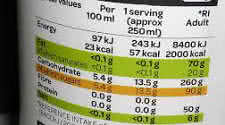Understanding Fortified & Enriched Food Labels Claims - Scam or No

Don't be fooled by everything you read on labels
Don't let the words "fortified" or "enriched" fool you. Fortification and enrichment are aimed to help the average person
maintain basic health. Those terms don't mean that a bodybuilder is necessarily going to get all the nutritional elements
he needs from Wonder Bread. It simply means that a few nutrients have been included in the product Each term has a specific
meaning when it appears on a label.
A manufacturer can tout that a food is fortified if a nutrient has been added that was either absent altogether from that
food or present only in insignificant amounts before processing. A manufacturer can advertise that a product has been
enriched if one or more nutrients have been jacked up during processing, because the food started out with lower than desirable
amounts. (Wonder Bread was one of the first enriched foods.)
The Food and Drug Administration (FDA) says that aiming to achieve and maintain a "desirable level of nutritional quality in
the nation's food supply is an important health objective." So it encourages the addition of specified nutrients to some
processed foods to prevent diseases we seldom hear of any more, such as beriberi and rickets.
Flour is a common ingredient that the government allows processors to enrich. A bread or pasta manufacturer may choose to use
wheat flour that hasn't been enriched. However, if the loaf of bread or box of pasta you buy advertises that it's enriched,
then it must have certain levels of iron (to combat anemia); thiamine, or vitamin B1 (to prevent muscle paralysis?; riboflavin,
or vitamin B2 (to aid respiratory metabolism): niacin (to help the body use carbs for energy): and folic acid (to fight birth
defects: in adults, deficiency shows up in symptoms such as irritability, poor growth and gastrointestinal disturbances). Milk
may be enriched with vitamin D (to prevent bone diseases); margarine and skim and low fat milk can be enriched with vitamin A
(to fend off vision problems).
Manufacturers aren't required to blatantly advertise that a food has been fortified or enriched. Even organic products can be
fortified or enriched. Take, for example, a package of organic tofu veggie slices (a cheese alternative made from soy) - you
can't get much healthier than that, you might think, and there should be no need to fortify it. However, read the label and you
might find that the product has been fortified with vitamin A. Organic milk, which is hormone-, antibiotic- and pesticide-free,
might have vitamin A palmitate added.
The list of foods fortified or enriched nowadays goes on and The FDA does, though, frown on manufacturers fortifying fresh
produce, meat poultry and fish, and snack foods, such as candy or soft drinks. Some manufacturers are proposing fortifying
or enriching junk food, such as potato chips, because they've become such a large part of the American diet. If it ever comes
to that though, consumers should not automatically consider a bag of vitamin-fortified potato chips to be a healthy food. Junk
food can't be made into a health food by adding a few nutrients.
Our suggestion, as always, is to eat a wide variety of minimally processed whole foods. Don't depend on a processed product such
as cereal, bread, pasta or milk that's been enriched or fortified. That wheat bread may have started out naturally brimming with
vitamins and minerals, but unless you live on a farm and bake it yourself from ingredients you grow yourself, it's handled, baked,
packaged, shipped, plunked on a store shelf, and who knows what else, before it gets to your table. Fortification and enrichment
are simply two cost effective ways of putting a few basic micronutrients into some of the foods you eat every day.